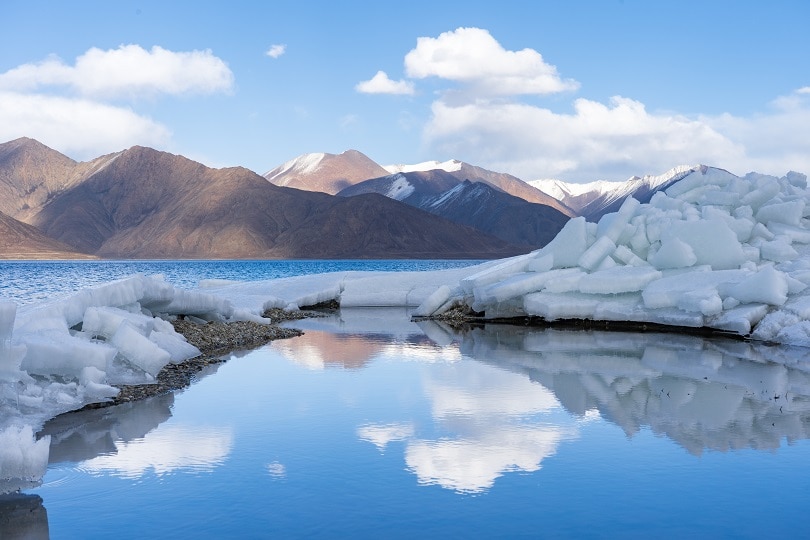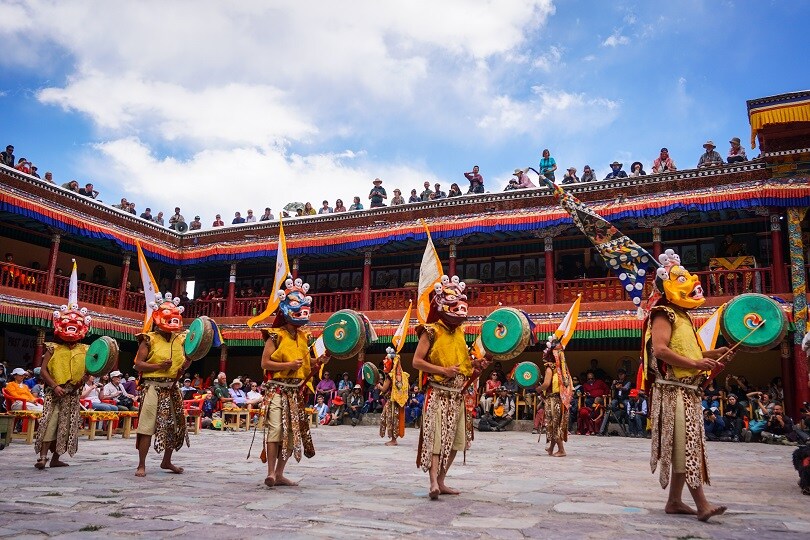Leh-Ladakh has gained quite an immense popularity in the last one decade. Tourists have been flocking in thousands to visit this magical Buddhist ex-kingdom. Famed for its unique culture and exceptional landscapes, Leh-Ladakh never fails to impress; no matter how many times you visit the place. If you want the best of experience, it is vital that you plan your visit per the climate of the mountains.
A few people consider June to August the best months to visit when the summer beauty of the land is at its full bloom. It is that time of the year when the snow melts and there is a buzz all-around of the vibrant Hemis Festival. While for the others, an authentic experience of the place can only be gained when the mountains are snow-clad. These are the months from December to February when the winter opens the gateway for various adventure activities in the valley such as the famous Chadar trek.
Helping you plan your visit wisely, here is a detailed description of the weather and the attractions in Leh-Ladakh during each month. Take a look!
Month-wise Weather in Leh-Ladakh
- January

(Temperature: Maximum -2°C, Minimum -14°C)
- The temperature remains sub-zero almost the entire month.
- Highways are covered with snow and remain frozen.
- The famous Zanskar River is frozen, serving as a crossing for trekkers (the frozen river trek is famously known as Chadar Trek).
- The region suffers cut-off in water supply with only six hours availability of electricity.
- This is the best time to interact with the locals as the number of tourists is low during this time.
- It is also the best time for snow leopard tracks.
- Spituk Gustor Festival is celebrated during this month.
- February

(Temperature: Maximum 1°C, Minimum -11°C)
- February is a little less intense than January but it is still very cold.
- The highways are still laden with snow and the lakes are frozen.
- The temperature being a little more than January prompts a few locals to open their shops and stores.
- There’s no water supply and only six hours of electricity supply.
- Dosmoche, Yargon Tungshak, Stok Guru Tsechu, Matho Nagrang festivals are held in this month.
- March

(Temperature: Maximum 6°C, Minimum -5°C)
- The temperature starts increasing in March. Though, the tourists from warmer regions may still feel cold.
- Days become sunny; however, nights remain frosty.
- Highways are still closed, and you can only fly in either from Delhi or Srinagar.
- Camping at Pangong Tso and Nubra Valley is also not feasible during this time.
- Matho Nagrang, Stok Guru Tsechu, Yargon Tungshak festivals are held in this month.
- April
(Temperature: Maximum 15°C, Minimum -1°C)
- By April, heavy snowfall stops and summer starts suffusing in the lives of the people of Ladakh.
- The city sees an influx of some tourists by this time. The city-hotels and local guest houses also open up.
- The only route to visit Ladakh is by air as the roads and high mountain passes are still not open.
- The weather, however, is still not sunny and warm as is during the peak summer season.
- May
(Temperature: Maximum 16°C, Minimum 3°C)
- By mid-May, snow thaws and the narrow city roads are crowded by the Indian Army’s winter stocking convoys. This sometimes creates difficulty for the civilian vehicles to move around.
- The effects of winter are not completely faded. The air in the region still feels cold.
- However, by late May, tourists start visiting the region, usually by air as the roads are still shut.
- There are chances that the Zoji La Pass (Leh-Srinagar route) is open for the travellers. It usually opens up by late May or early June.
- The Rohtang Pass (Leh-Manali route), however, is still closed in May.
- June

(Temperature: Maximum 21°C, Minimum 7°C)
- By early June, all the road routes to Leh open up and one can quickly travel to Leh via the Srinagar-Leh-Manali Circuit.
- If you wish to see snow-covered roads and mountains en route, this is the perfect time to visit Leh-Ladakh.
- However, for the initial seven to ten days, the roads are in an unstable condition due to snow-slides and roadblocks. So, plan your trip wisely.
- By mid-June, the snow starts to melt. So you will come across various water crossings and streams en route.
- Saka Dawa, Yuru Kabgyat. Sindhu Darshan and Hemis festivals are celebrated in this month.
- July-August
(Temperature: Maximum 25°C, Minimum 10°C)
- By this time, all passes and roads to Ladakh are open. The landscape is inviting; offering spectacular views to tourists.
- If you are planning a road trip via the Manali-Leh Highway, leave from Manali early in the morning to avoid the heavy traffic jam at the Rohtang Pass.
- If you are planning a road trip from the Srinagar-Leh Highway, leave from Srinagar early in the morning to avoid the traffic jam in Sonmarg.
- Stongday, Karsha, Phyang, Sachukul, Karzok, Dakthok and Sani Nasjal festivals are celebrated during these this month.
- September

(Temperature: Maximum 21°C, Minimum 5°C)
- This time of the year has mixed climatic conditions in Leh-Ladakh. Early September offers abundant natural beauty all-around. However, by the end of the month, winter begins in the mountains.
- The hotel rates come down as not many people visit the region during this time. Many campsites are either on the verge of closing or are already closed by the mid-September.
- The weather starts getting cold and it might snow during late September.
- The landscape is barren and rocky, as the glaciers stop melting by this time
- Though the roads are in good condition, occasional snowfall can sometimes create blockages.
- October

(Temperature: Maximum 14°C, Minimum -1°C)
- By this time, most of the tourists leave and only some passionate travellers stay.
- Regular snowfall starts and cold winds blow over the mountains.
- The Manali-Leh highway is open but gets covered with snow. Most of the guest houses and eating joints are also closed on this route.
- The Diskit Festival is celebrated during this month.
- November

(Temperature: Maximum 7°C, Minimum -6°C)
- Temperature starts to drop below the freezing point, especially during the nights.
- Highways are covered with snow leaving flights as the only option to reach the region during this time of the year.
- Lakes freeze due to the cold weather; camping beside Pangong Tso is not possible.
- Angeethi and body warmers are needed to keep warm.
- The water supply is also not available from November.
- Electricity is available for only six hours a day.
- Thiksey and Padum festivals are celebrated in this month.
- December
(Temperature: Maximum 2°C, Minimum -11°C)
- This month marks the beginning of Leh-Ladakh’s bone-chilling winter.
- Highways and passes remain closed owing to excessive snowfall.
- Snow layers as thick as six inches can be found over the lakes and rivers.
- Losar and Galdan Namchot festivals are celebrated during this month.
With all this information at hand, all you need to do is choose a month that suits your travel plans the best. In the end, you’ll realise that a visit to Leh-Ladakh is an experience of a lifetime.
- Top 16 Things to do in Kolkata in 24-hours - July 25, 2019
- Savour These Delicacies While in Bali for a True Gastronomical Treat! - May 29, 2019
- A Seasonal Guide to Sri Lanka – The Pearl of the Indian Ocean 2019 & 2020 - May 24, 2019
- Six Experiences You Mustn’t Miss in Sri Lanka for A Fabulous Trip! - May 24, 2019
- 5 Bazaar Ramadan terbaik di Kuala Lumpur. - May 15, 2019
- Planning to Visit Ladakh? Here is a Seasonal Guide to Help You Plan Your Trip - May 8, 2019
- Visit These Places in Bali For an Exciting Vacation in The Tropical Island! - May 7, 2019
- 8 Best Places to Spend Your Vacation in the Hills of Himachal Pradesh - April 17, 2019
- Places to Visit in Thailand - April 16, 2019
- Want to Visit Bali at Minimum Cost? Follow Our Guide to Travel Bali on a Budget! - April 12, 2019

